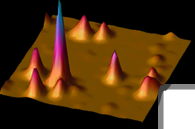Single-Molecule Projects
Biophysics and Single-Molecule Tracking (2D and 3D) in Cells, with Selected Early Projects (since 1995)
Motional dynamics of single Patched1 molecules in cilia are controlled by Hedgehog and cholesterol
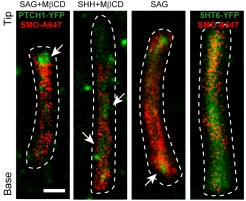 The Hedgehog-signaling pathway is an important target in cancer research and regenerative medicine; yet, on the cellular level, many steps are still poorly understood. Extensive studies of the bulk behavior of the key proteins in the pathway established that during signal transduction they dynamically localize in primary cilia, antenna-like solitary organelles present on most cells. The secreted Hedgehog ligand Sonic Hedgehog (SHH) binds to its receptor Patched1 (PTCH1) in primary cilia, causing its inactivation and delocalization from cilia. At the same time, the transmembrane protein Smoothened (SMO) is released of its inhibition by PTCH1 and accumulates in cilia. We used advanced, single molecule-based microscopy to investigate these processes in live cells. As previously observed for SMO, PTCH1 molecules in cilia predominantly move by diffusion and less frequently by directional transport, and spend a fraction of time confined. After treatment with SHH we observed two major changes in the motional dynamics of PTCH1 in cilia. First, PTCH1 molecules spend more time as confined, and less time freely diffusing. This result could be mimicked by a depletion of cholesterol from cells. Second, after treatment with SHH, but not after cholesterol depletion, the molecules that remain in the diffusive state showed a significant increase in the diffusion coefficient. Therefore, PTCH1 inactivation by SHH changes the diffusive motion of PTCH1, possibly by modifying the membrane microenvironment in which PTCH1 resides.
The Hedgehog-signaling pathway is an important target in cancer research and regenerative medicine; yet, on the cellular level, many steps are still poorly understood. Extensive studies of the bulk behavior of the key proteins in the pathway established that during signal transduction they dynamically localize in primary cilia, antenna-like solitary organelles present on most cells. The secreted Hedgehog ligand Sonic Hedgehog (SHH) binds to its receptor Patched1 (PTCH1) in primary cilia, causing its inactivation and delocalization from cilia. At the same time, the transmembrane protein Smoothened (SMO) is released of its inhibition by PTCH1 and accumulates in cilia. We used advanced, single molecule-based microscopy to investigate these processes in live cells. As previously observed for SMO, PTCH1 molecules in cilia predominantly move by diffusion and less frequently by directional transport, and spend a fraction of time confined. After treatment with SHH we observed two major changes in the motional dynamics of PTCH1 in cilia. First, PTCH1 molecules spend more time as confined, and less time freely diffusing. This result could be mimicked by a depletion of cholesterol from cells. Second, after treatment with SHH, but not after cholesterol depletion, the molecules that remain in the diffusive state showed a significant increase in the diffusion coefficient. Therefore, PTCH1 inactivation by SHH changes the diffusive motion of PTCH1, possibly by modifying the membrane microenvironment in which PTCH1 resides.
Lucien E. Weiss, Ljiljana Milenkovic, Joshua Yoon, Tim Stearns, and W. E. Moerner, “Motional dynamics of single Patched1 molecules in cilia are controlled by Hedgehog and cholesterol,” Proc. Nat. Acad. Sci. (USA) (in press 2019) (DOI: 10.1073/pnas.1816747116, published online 28 February 2019). DOI [![]() Slide]
Slide]
Single locus tracking with proper accounting of static and dynamic errors in the presence of fractional Brownian motion, with an example from tracking chromosomal loci in yeast
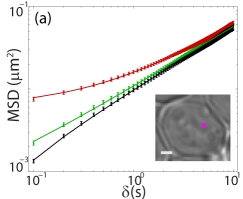 The mean-squared displacement (MSD) and velocity autocorrelation (VAC) of tracked single particles or molecules are ubiquitous metrics for extracting parameters that describe the object's motion, but they are both corrupted by experimental errors that hinder the quantitative extraction of underlying parameters. For the simple case of pure Brownian motion, the effects of localization error due to photon statistics ("static error") and motion blur due to finite exposure time ("dynamic error") on the MSD and VAC are already routinely treated. However, particles moving through complex environments such as cells, nuclei, or polymers often exhibit anomalous diffusion, for which the effects of these errors are less often sufficiently treated. We present data from tracked chromosomal loci in yeast that demonstrate the necessity of properly accounting for both static and dynamic error in the context of an anomalous diffusion that is consistent with a fractional Brownian motion (FBM). We compare these data to analytical forms of the expected values of the MSD and VAC for a general FBM in the presence of these errors.
The mean-squared displacement (MSD) and velocity autocorrelation (VAC) of tracked single particles or molecules are ubiquitous metrics for extracting parameters that describe the object's motion, but they are both corrupted by experimental errors that hinder the quantitative extraction of underlying parameters. For the simple case of pure Brownian motion, the effects of localization error due to photon statistics ("static error") and motion blur due to finite exposure time ("dynamic error") on the MSD and VAC are already routinely treated. However, particles moving through complex environments such as cells, nuclei, or polymers often exhibit anomalous diffusion, for which the effects of these errors are less often sufficiently treated. We present data from tracked chromosomal loci in yeast that demonstrate the necessity of properly accounting for both static and dynamic error in the context of an anomalous diffusion that is consistent with a fractional Brownian motion (FBM). We compare these data to analytical forms of the expected values of the MSD and VAC for a general FBM in the presence of these errors.
Mikael P. Backlund, Ryan Joyner, and W. E. Moerner, “Chromosomal locus tracking with proper accounting of static and dynamic errors,” Phys. Rev. E 91, 062716 1-12 (2015) (DOI: 10.1103/PhysRevE.91.062716, published online June 29, 2015). DOI
Single-molecule imaging of Hedgehog pathway protein Smoothened in primary cilia reveals binding events regulated by Patched1
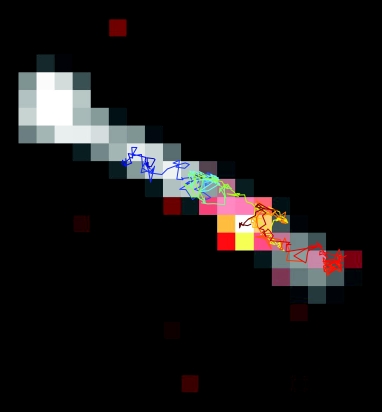 Accumulation of the signaling protein Smoothened (Smo) in the membrane of primary cilia is an essential step in Hedgehog (Hh) signal transduction, yet the molecular mechanisms of Smo movement and localization are poorly understood. Using ultrasensitive single-molecule tracking with high spatial/temporal precision (30 nm/10 ms), we discovered that binding events disrupt the primarily diffusive movement of Smo in cilia at an array of sites near the base. The affinity of Smo for these binding sites was modulated by the Hh pathway activation state. Activation, by either a ligand or genetic loss of the negatively acting Hh receptor Patched-1 (Ptch), reduced the affinity and frequency of Smo binding at the base. Our findings quantify activation-dependent changes in Smo dynamics in cilia and highlight a previously unknown step in Hh pathway activation. These results demonstrate the continuing power of single-biomolecule tracking in cells, where the behavior of the single molecules tell the story and allow measurement of specific kinetic binding constants in a living cell.
Accumulation of the signaling protein Smoothened (Smo) in the membrane of primary cilia is an essential step in Hedgehog (Hh) signal transduction, yet the molecular mechanisms of Smo movement and localization are poorly understood. Using ultrasensitive single-molecule tracking with high spatial/temporal precision (30 nm/10 ms), we discovered that binding events disrupt the primarily diffusive movement of Smo in cilia at an array of sites near the base. The affinity of Smo for these binding sites was modulated by the Hh pathway activation state. Activation, by either a ligand or genetic loss of the negatively acting Hh receptor Patched-1 (Ptch), reduced the affinity and frequency of Smo binding at the base. Our findings quantify activation-dependent changes in Smo dynamics in cilia and highlight a previously unknown step in Hh pathway activation. These results demonstrate the continuing power of single-biomolecule tracking in cells, where the behavior of the single molecules tell the story and allow measurement of specific kinetic binding constants in a living cell.
Ljiljana Milenkovic* Lucien E. Weiss*, Joshua Yoon, Theodore L. Roth, YouRong S. Su, Steffen J. Sahl, Matthew P. Scott, and W. E. Moerner (*equal contributions), "Single-molecule imaging of Hedgehog pathway protein Smoothened in primary cilia reveals binding events regulated by Patched1," Proc. Nat. Acad. Sci. (USA) 112, 8320-8325 (2015) (DOI: 10.1073/pnas.1510094112 published online 13 October 2014). DOI [![]() Slide]
Slide]
Two-Color, 3D Tracking of Pairs of DNA Loci in Budding Yeast with High Spatio-Temporal Resolution
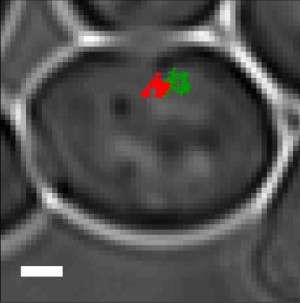 Single-particle tracking has been applied to study chromatin motion in live budding yeast cells, revealing a wealth of dynamical behavior of the genomic material once thought to be relatively static throughout most of the cell cycle. Here, we employed the dual-color 3D Double-Helix Point Spread Function (DH-PSF) microscope to study the correlations of movement between two fluorescently labeled gene loci on either the same or different budding yeast chromosomes. We performed fast (10 Hz) 3D tracking of the two copies of the GAL locus in diploid cells in both activating and repressive conditions. As controls we tracked pairs of loci along the same chromosome at various separations, as well as transcriptionally orthogonal genes on different chromosomes. We found that under repressive conditions the GAL loci exhibited significantly higher velocity cross-correlations than they did under activating conditions. This relative increase has potentially important biological implications, as it might suggest coupling via shared silencing factors or association with decoupled machinery upon activation. We also found that on the time scale studied (~0.1-30 s), the loci moved with significantly higher subdiffusive mean square displacement exponents than previously reported, which has implications for the application of polymer theory to chromatin motion in eukaryotes.
Single-particle tracking has been applied to study chromatin motion in live budding yeast cells, revealing a wealth of dynamical behavior of the genomic material once thought to be relatively static throughout most of the cell cycle. Here, we employed the dual-color 3D Double-Helix Point Spread Function (DH-PSF) microscope to study the correlations of movement between two fluorescently labeled gene loci on either the same or different budding yeast chromosomes. We performed fast (10 Hz) 3D tracking of the two copies of the GAL locus in diploid cells in both activating and repressive conditions. As controls we tracked pairs of loci along the same chromosome at various separations, as well as transcriptionally orthogonal genes on different chromosomes. We found that under repressive conditions the GAL loci exhibited significantly higher velocity cross-correlations than they did under activating conditions. This relative increase has potentially important biological implications, as it might suggest coupling via shared silencing factors or association with decoupled machinery upon activation. We also found that on the time scale studied (~0.1-30 s), the loci moved with significantly higher subdiffusive mean square displacement exponents than previously reported, which has implications for the application of polymer theory to chromatin motion in eukaryotes.
Mikael P. Backlund, Ryan Joyner, Karsten Weis, and W. E. Moerner, “Correlations of three-dimensional motion of chromosomal loci in yeast revealed by the Double-Helix Point Spread Function microscope," Molec. Biol Cell 25, 3619-3629 (2014) (DOI: 10.1091/mbc.E14-06-1127, published online 13 October 2014). DOI [![]() Slide]
Slide]
Superresolution Imaging in Live C. Crescentus Cells Using Photoswitchable EYFP [![]() Slide] [journal link: Nature Meth.]
Slide] [journal link: Nature Meth.]
Visualization of Long Human Telomere Mimics by Single-Molecule Fluorescence Imaging [![]() Slide] [journal link: JPC B Letter]
Slide] [journal link: JPC B Letter]
Cy3-Cy5 Covalent Heterodimers for Superresolution Imaging [![]() Slide] [journal link: JPC B Letter]
Slide] [journal link: JPC B Letter]
New Photoactivatable Single-Molecule Fluorophores [![]() Slide] [journal link: JACS]
Slide] [journal link: JACS]
Single-Molecule Motions of Oligoarginine Transporter Conjugates on the Plasma Membrane of CHO Cells
[![]() Slide] [journal link: JACS]
Slide] [journal link: JACS]
Water-Soluble DCDHF Single-Molecule Fluorophores [![]() Slide]
Slide]
Detecting Single Oligonucleotides
with DCDHF Self-Quenched Intermolecular H-Dimers (SQuIDs)
[Slide] [Journal
Link] [Movie
showing two-step bleaching]
Recent Progress in DCDHF Single-Molecule Emitters [Slides]
Single
Molecules of Bacterial Actin MreB Undergo Directed Treadmilling
Motion in Caulobacter Cells
[![]() Full
Text] [Journal
link] [Supporting
material] [movie1]
[movie2]
[movie3]
[movie4]
Full
Text] [Journal
link] [Supporting
material] [movie1]
[movie2]
[movie3]
[movie4]
Cholesterol
Depletion Induces Solid-Like Regions in the Plasma Membrane [![]() Full
Text]
Full
Text]
DCDHF
Molecules as Lipid-like Plasma Membrane Probes [![]() Full
Text]
Full
Text]
Diffusion of Single GFP Fusions in
Bacteria [![]() Full
Text ]
[Slide]
[Journal
link]
Full
Text ]
[Slide]
[Journal
link]
New Fluorophores for Cellular Imaging [![]() Full
Text]
[Slide]
Full
Text]
[Slide]
Effect of Cholesterol on Motion of
Single Transmembrane Proteins in CHO Cells [![]() Full
Text]
[
Full
Text]
[![]() Slide]
Slide]
Observing Individual Enzyme Turnovers [Slide]
Nucleotide-Dependent Orientations of Kinesin Motors on Microtubules (Nat. Struct. Bio. Cover and News and Views, June 2001) [Slide]
DsRed: A Red Fluorescent Protein, Single and Many Molecules [Slide]
Single-Molecule pH Sensors [Abstract]
Single-Molecule Reporters of Calcium Concentrations Using FRET in a Dual-GFP Construct [Abstract]
Summary (1998): Single Molecule Spectroscopy and Biophysics [Slides]
Blinking and Switching of Single Green Fluorescent Protein Molecules [Abstract]
Polyacrylamide Gels for Single Molecule Imaging and Biophysics [Abstract]
